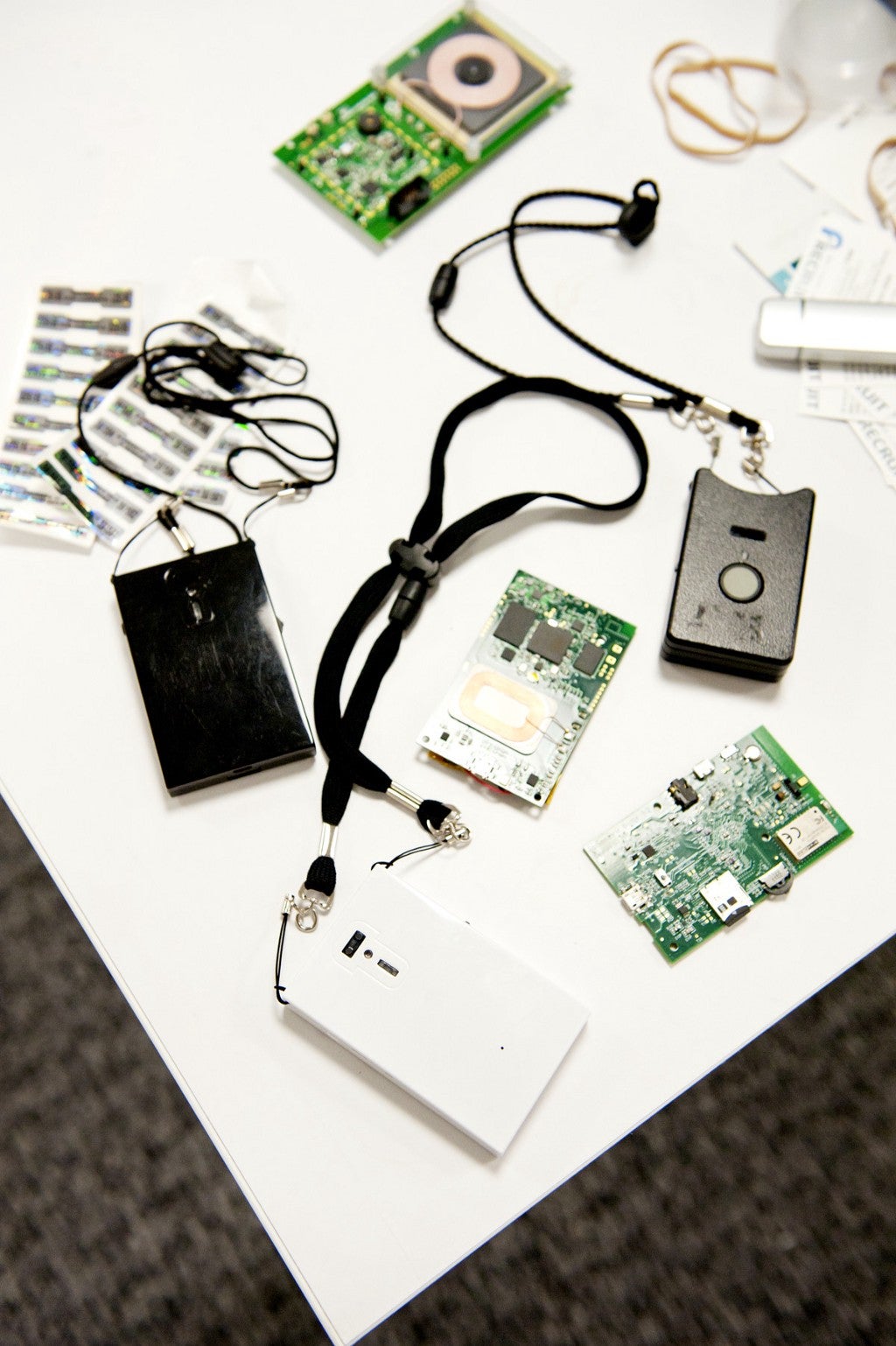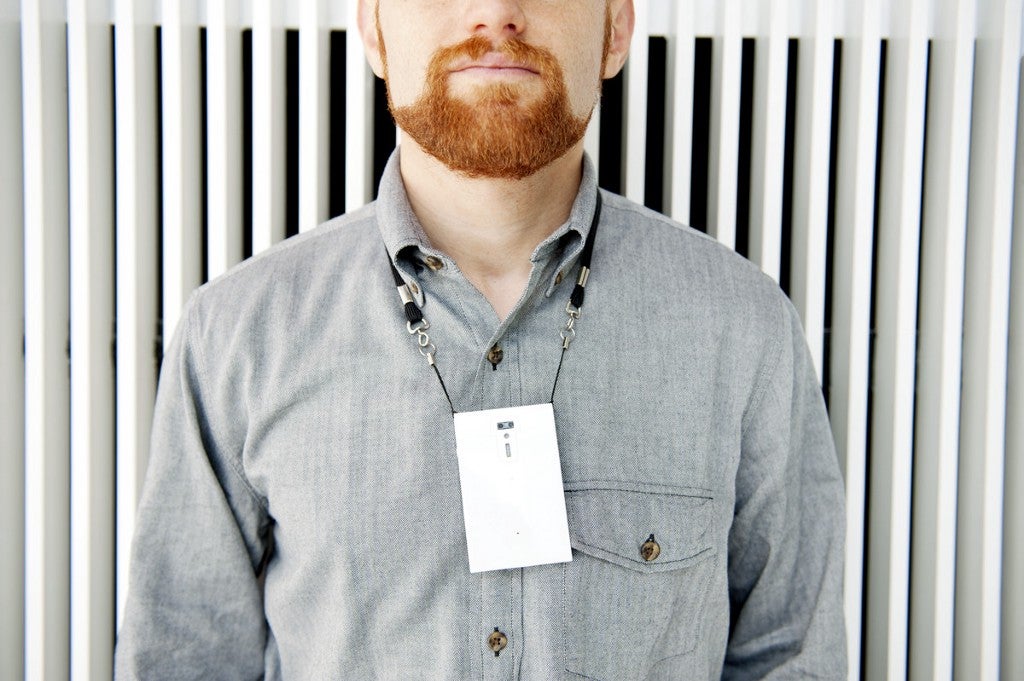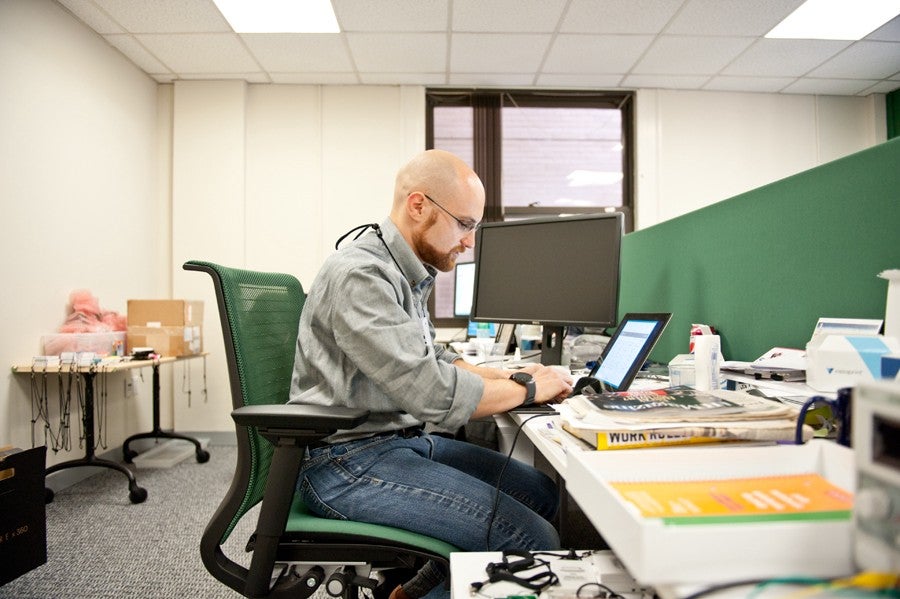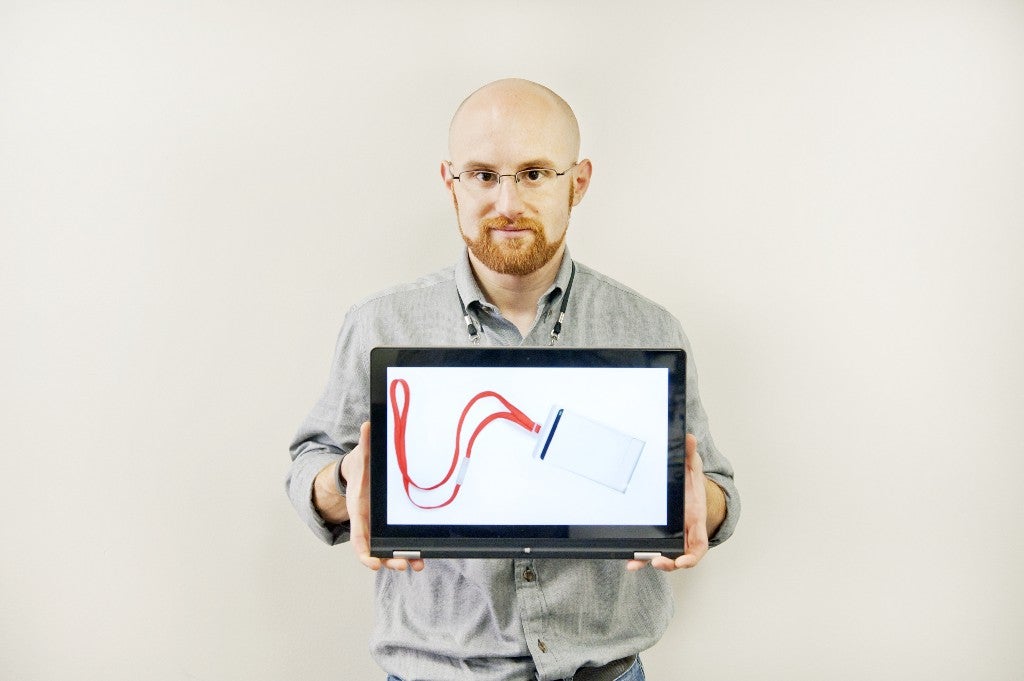Ben Waber stands at the south end of a long white conference table. On the table sits a projector, its lens aimed at the conference room’s off-white wall. But rather than let his presentation slides project on the wall behind him, Waber stands in the beam’s path. The first slide from his PowerPoint presentation, “People Analytics,” illuminates the upper half of his torso, the insignia for the Massachusetts Institute of Technology splayed on his left pectoral.
He introduces himself to his audience — 18 members of Deloitte LLP’s marketing and communications division, the people tasked with maintaining Deloitte’s image as the reigning leader in the consulting industry — as they pick at boxed lunches. “Hey, everybody, my name is Ben Waber,” he enthuses over the hum of mastication. “Yes, I’ll be your lunchtime accompaniment.”
The crowd musters a muffled laugh.
“I’m a visiting scientist at MIT,” he continues. “Which means when they want someone to talk about data in organizations, they trot me out.”
Bearded, bald and compact, Waber speaks with the energy of a precocious teenager brimming with excitement about his own thoughts. When he’s not enthusiastically gesticulating, he rests his hands in front of him, right hand covering left fist, as if he were a sensei. He rarely stops smiling.
“But now, the vast majority of my time is spent running a company called Humanyze, which was spun directly out of research we did here at MIT.”
Selling a solution first requires identifying a problem — which, for Waber, means convincing the room that they have no fucking clue what they’re doing.
Waber and Humanyze specialize in a nascent corporate management discipline called “people analytics”: the use of data science to tackle corporate management issues such as hiring, firing, performance evaluation and team design — matters often misperceived as wholly qualitative problems. To gather this data, Humanyze monitors how a company’s employees interact with one another and then suggests how the company can create a more collaborative, creative work environment and, in turn, boost employee performance both individually and collectively. It’s Big Data meets HR, essentially.
It’s also cutting-edge stuff: People analytics didn’t exist 10 years ago, and only came into vogue two years ago, when Waber literally wrote the book on the subject. Humanyze, the company he co-founded in 2011, secured $1 million in VC funding in February and already has a handful of Fortune 100 clients (many of which Waber says he’s not at liberty to disclose).
The company’s early success is almost entirely predicated on the device currently dangling from Waber’s neck. The device itself is unremarkable — bulky, white and rectangular, it’s reminiscent of a first-generation iPod. Even its name — “Sociometric Badge,” derived from Humanyze’s parent company, Sociometric Solutions — underwhelms. But the badge’s clunkiness belies its potential; Waber believes the device has the potential to revolutionize how we think about labor once it’s deployed at scale, and that within five years, it will be as commonplace as corporate I.D. cards.
The device contains the following sensors:
- A microphone: To track the volume, pitch and speed of an individual’s speech and the interruptions and “turn-taking” dynamics of their conversations with colleagues. (Turn-taking is Waber’s term for the order of who talks when in a conversation.) The device doesn’t record the content of conversations, though, allaying some privacy concerns.
- An accelerometer: To measure the user’s physical activity, posture and “mirroring” (i.e., whether he mimics his colleague’s body language when in conversation).
- Infrared: To gauge where (and whom) the user faces when speaking.
- Bluetooth: To indicate the user’s location and proximity to other workers.
Waber has yet to acknowledge the device to his audience, though. Selling a solution first requires identifying a problem, which, for Waber, means convincing the room that they have no fucking clue what they’re doing, at least as it pertains to managing and interacting with their co-workers.

See, somehow in a Moneyball, Nate Silver, data-centric world, companies still fail to apply data science to how they manage their workers. Executives love to belabor the importance of talent, culture and teamwork, but they have no way to quantify those values, let alone to use them to optimize their management, according to Waber.
Waber’s device affords companies the chance to plunge these uncharted depths. The only thing workers have to do is agree to have their employers (and Humanyze) track their every movement and word.
Location tracking is a particularly “creepy” proposition, Waber concedes, evoking a round of uneasy laughter. But everyone in the room already subjects themselves to this kind of data capture, he reminds them. “We’re already carrying around with us devices that measure all the stuff that we do. We have cell phones in our pockets, right?”
Waber’s next three slides are stock photos of faux professional settings: a woman giving an inquisitive look to her female colleague during a lunch meeting; an Asian man staring at his laptop; an attractive male-female duo who radiate joy as the man points to a computer.
If wearing a badge is a means to becoming a more high-functioning employee, then the questions becomes: Why wouldn’t someone want to wear one?
“For example, if you’re brainstorming ideas, if you’re making a decision, how balanced should the conversation be? Pretty much universally the consensus is if we’re trying to come up with new ideas, trying to make a decision, and one person talks 80 percent of the time — I don’t care how smart they are, I don’t care what their role is — you’re gonna come up with crappy ideas.
“Even when you’re by yourself, you’re generating a lot of interesting data. Looking at your posture is indicative of the kind of work and the kind of conversation you’re having. In general, as you get more engaged in the work you do, as you get more in sync with someone you’re having a conversation with, your posture will start to lean in.”
A woman in a pink shirt and white pants with pink flamingos raises her hand and asks a question: “You’re just required as an employee to wear it?”
“We do this on an opt-in basis,” Waber tells her. “We’ve got over 90 percent of participation in every single roll-out that we’ve done, so we’ve gotten good at that.”
The key to the high participation rate in the face of obvious privacy concerns is that wearing the device actually works, Waber says. It provides insights into how workers can improve their individual performance. Waber cites Humanyze’s work with the Sacramento Kings as an example. The Kings have outfitted all of their season-ticket salespeople with Sociometric badges. “And we can predict very, very accurately how much any one of them is gonna sell in a given night, just by looking at how active they are, as well as how they talk.”

If wearing a badge is a means to becoming a more high-functioning employee, then the questions becomes: Why wouldn’t someone want to wear one?
Waber stops short of saying exactly what makes certain salespeople more successful than their peers, though — that’s the kind of information Deloitte will have to pay for.
“But the rubber really hits the road when you use it for A/B testing.”
A/B testing is the digital marketing technique in which a web company — like, say Amazon, which A/B tests rigorously — will show two different product options to two demographically similar sets of consumers in order to determine which product display induces a higher click-through and/or purchase rate.
But a company that conducts A/B testing on its workforce turns its employees into corporate guinea pigs. One group is the control; the other is the experimental group exposed to the independent variable. Granted, the independent variables in these cases would be innocuous ones, such as a new sales training methodology or having half the engineers move their desks closer to the finance department. But it still means treating laborers as data points, which doesn’t exactly jibe with the goal indicated in the company name.
Humanyze aims to practice a sort of socio-technological jiu-jitsu: Rather than recommend less technology in the workplace, it’s using more technology to combat the dehumanizing effects technology has had on work.
At the very least, Humanyze is a means for companies to make more educated decisions. Most executives just mimic what they read about in Harvard Business Review, Waber tells the room, never basing their decisions in anything quantifiable. “It’s fascinating that companies make multimillion-dollar bets because someone just feels like it’s a good idea.”
Heads nod in agreement.
A perfect example of this blind decision making is Facebook commissioning legendary architect Frank Gehry to design its new corporate headquarters. The building’s open design was heralded as a way to increase collaboration, but there’s no data proving that causal link. Or as Waber later puts it: “They got Frank Gehry to crumple up some paper and say, ‘That’s your new office.’ Because it looks cool.”
Waber moves to a slide of a nondescript call center — a narrow hallway with two parallel rows of hexagonal work pods. The workers nestled in the pods are wearing headsets and staring at bulky computer monitors. Two supervisors dressed in all black walk the thin aisle separating the rows of pods and lord over the underlings. It looks like misery.
“Bank of America came to us, and they said, ‘Some of our call centers perform better than others. We don’t understand why because everyone has the same training. And the employee demographics look very similar.’ So what was it?”
Bank of America was scheduling employee lunch breaks incorrectly.
Conventional call center wisdom dictated that any time employees spent talking to one another instead of fielding calls was time wasted. Employee breaks were staggered to minimize colleague interaction — a team could only have one person on break at a time to ensure there were enough people to answer the phones.
But Humanyze found the most productive teams were ones whose members interacted with one another the most. “It turned out that every day there was about a 15-minute period when some people’s lunch breaks would overlap. That’s when 80 percent of the interactions happened. And if you have these interactions, your stress goes down that day.”
Humanyze advised having some teams take lunch as a group. “Cohesion went up by about 18 percent,” Waber explains. (Cohesion being how much members of the same group spoke with one another.) “Stress went down significantly, by about 19 percent. Again, previously, if you had a tough call with a customer you just didn’t have any opportunities to vent, and now you do.
The Humanyze office is a deserted mess. Computers and mobile devices of various makes and models have been disassembled, their guts strewn about the floor.
“This number is really interesting, though: People completed calls 23 percent more quickly in these groups.”
Impressive as Humanyze’s Bank of America example might be, it does little for those present: Deloitte’s marketing and communication teams work remotely. Again, Waber tells the room that they’ve adopted an ill-informed internal policy. When it comes to fostering creativity and workplace happiness, there’s no substitute for having colleagues occupy the same physical space, Waber says. “Because fundamentally, the whole reason we’re a company is because together we can do something that we couldn’t do by ourselves.”
This stance makes Waber something of a hypocrite considering Humanyze, which is based in Boston, just opened a Palo Alto office in order to better service demand in the region. Sales-wise, it’s sound. But culture-wise, it means sacrificing the kind of cohesion the company claims is of the utmost importance to an organization’s future. Waber’s solution has been to call his Palo Alto employees at random and discuss… whatever.
“It’s not planned. It’s not a meeting. I don’t talk about anything. I say about three-quarters of the time it ends up being about work, but the other 25 percent of the time, it’s, ‘How are your kids doing? You see that show on TV last night?’ Because that’s the stuff that gets lost when you’re remote.”
Later, he says: “Especially in the U.S. we have this idea that when you’re in meetings all day, that’s productive. But spending 30 minutes with a colleague having coffee, that’s wasting time.”
A woman two seats from where Waber is standing laughs. But a bald British man at the head of the table opposite Waber remains unamused. He hasn’t smiled once throughout the presentation, and he seems intent on undermining Waber’s methodology. For the second time, he points out a flaw in Humanyze’s research.

“You say employee behavior goes back to normal after two days, but that’s a new normal. Because you didn’t know what the previous normal was,” the Brit says flatly, referencing Waber’s earlier point about how employees tend to act rigid their first two days wearing the device before reverting to their “normal” habits.
The Brit’s point is that this supposed normal is also bogus, and it’s valid; humans alter their behavior once they know they’re being observed. It’s a phenomenon known as “The Hawthorne Effect” (which Waber points out himself).
Some background: In 1924, Harvard Business School professor Elton Mayo embarked on a nine-year “worker behavior” study at the Western Electric Hawthorne Works plant in suburban Chicago. The study was unprecedented in scope, and its primary finding was that a large company tends to “lack any satisfactory criterion of the actual value of its methods of dealing with people.”
Which is more or less exactly what Waber is saying more than 80 years later. But in the 1960s critics attacked Mayo’s research as unreliable, saying the employees’ reactions were altered by the presence of the researchers. “If you’re faking it for six months, that’s your behavior,” Waber argues. “I don’t care that you’re faking it.”
“I know we’re running out of time, so I’ll just talk about one more thing, which is gender at work.”
Waber changes the slide, and the audience erupts with laughter. It’s a photo of a bow-tied, bespectacled man reaching his arm across his desk to shake hands with a female subordinate. A caption bubble emanating from his mouth reads, “I LOOK FORWARD TO LIMITING YOUR GROWTH.”
“If we have a vote, who thinks that men and women have statistically significant different behaviors at work?”
Everyone in attendance raises his or her hand. Waber changes the slide again, projecting the word “No” on the wall.
Waber’s vision is to outfit these otherwise forgettable objects with internet connectivity so that they can one day respond to Humanyze data in real time.
Humanyze has found no significant statistical difference between how men and women communicate in the workplace. Of all the counterintuitive insights he’s revealed, this elicits the most hushed side conversations.
“You’ve got some men who talk a lot, and some men who don’t talk a lot; some women who talk a lot, and some women who don’t talk a lot. Basically, it washes itself out.”
The only possible explanation for the workplace gender gap, Waber argues, is bias. Men hold 83 percent of upper-management positions, and they’re reluctant to promote women because they fear women are more concerned with raising children than with their careers.
Waber concedes this is a problem Humanyze can’t remedy. But: “As a company, the things we can start to do are the things that Apple has started to do, where you have women executives make major announcements. That creates a visible female role model. But you need to realize that it isn’t gonna make a difference in the short term; it’s just not. That’s frustrating, because in the U.S., especially, the mindset is I want to change something, and I want it to happen now.”
“Um, so I’m over time. I’ve got some other cool stuff about Harry Potter that I can’t talk about.”
“Awwww,” the crowd moans.
The Deloitte employees are ushered out of the conference room. Waber and I gather our things and starts for the Humanyze office (across the Charles River in Boston proper). “The saddest thing for me is when people say, ‘I hate my job,’” he says. “That’s where you spend the majority of your waking hours. Communication, in general, has the ability to dramatically improve that.”
The Humanyze office is a deserted mess. Computers and mobile devices of various makes and models have been disassembled, their guts strewn about the floor. Waber settles into the plaid couch in one of the office’s small meeting rooms. Across from him a whiteboard leans against the wall, a list of office items written on it — “Chair,” “Filing Cabinet,” “Cubicle Wall,” “HVAC.” Waber’s vision is to outfit these otherwise forgettable objects with internet connectivity so that they can one day respond to Humanyze data in real time.
The mind runs wild imagining how this system might operate. Humanyze detects an employee has had insufficient interaction with members of the design team. So when he comes into work the next morning, he’s been automatically reassigned to sit among the designers. Humanyze senses another employee’s productivity falling and adjusts the office lighting to give him a boost of energy. Humanyze recognizes someone works best in a noisy office and retracts his cubicle walls to allow more fluid interactions with colleagues.
The office basically manages itself.
Waber, of course, refrains from speculating about how Humanyze will one day work in conjunction with these objects. He doesn’t want to theorize until he sees the data.
